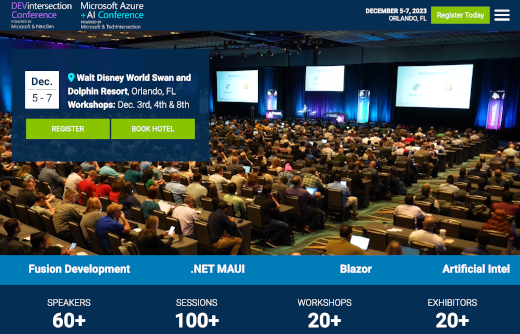Retail Returns Happen - Always Have, Always Will

AI-generated image of a mass of people returning merchandise at a store by DALL-E
Over the Christmas holiday last year, I started reading news stories regarding the increasing volume of returns to both online and brick-and-mortar retailers. In them they discussed the business and logistics of returns to how returns are mounting despite efforts by retailers to curtail them.
On the surface, it sounds like this is a relatively new phenomenon. Most people reading this post have likely returned something to Amazon or some other retailer recently or even this week. The volume of returns has been growing over the years, combining among other reasons the move to buying more items online that – though you can see pictures of it – you are not actually touching the item until you receive it, to simply more competition in the retail space, where you may find a lower price the next day.
However returning merchandise is nothing new. Where I am not a retail industry expert by any stretch, I’d like to share my unique point of view on retail returns as I had some education on this from my Aunt who years ago who worked for a local department store. She was a long-time employee of Steiger’s, a family-owned chain of stores in western Massachusetts and northern Connecticut. They had about a dozen stores in total before they closed down in the early 90s and sold off their stores to Filene’s, eventually to be engulfed by Macy’s.
What’s Old Is...
My aunt’s job at Steiger’s was processing returned merchandise at the company headquarters. Returns would come into her office from all of the stores. Some items were truly damaged or had some defect. Others were still new and just not wanted, and some were likely worn once and then returned as no longer needed. In some cases items were returned to the manufacturer, but often the maker did not want them back and would simply refund the store. Those items were kept and she facilitated a quarterly sale for employees where they could buy the items for pennies on the dollar of their original retail price. Needless to say, we had a lot of items around our house and clothes in our closet from those sales.
When I was old enough to understand about money and how much things cost, my Aunt explained to me about the business of returns and how that fit into the overall cost and pricing of merchandise. She told me, for example, if an item on the rack at the store had a sticker price of $100, the actual cost to Steiger’s for the item may have been as low as $10, of course depending on the brand. That allowed profit to be made with discounts that you see stores offering for 10% to 30% off right-away on new merchandise. It also allowed for profit to be made when the sticker price is reduced over time; even at 50% off a profit can be made. The items on a deep-discount rack were also helping the bottom-line of the store.
After my Aunt came over to our house with things she got from the employee sale – not going to lie, she would set aside things for her sister and niece and nephew – even then there was some profit made by the store. When manufacturers and wholesalers gave credit back to the store it was to offset the fact that they didn’t want the items back or it cost more to ship and process them than their actual value. Rather than throw them away, the 4 times a year sale became an employee perk.
... Not Necessarily New
Now fast-forward to present day. The 800 lb. gorilla in the room, Amazon, has been facing a growing number of returns as, well, people have been buying more from them. They have built an evolving infrastructure to manage them, from returns to Amazon lockers, Kohl’s department stores and UPS Stores to crediting your account now or doing a cash refund days later, to asking more and more questions as to why you are returning an item. Other online retailers are using third-party services for similar drop-off returns, as I have gone to random stores to bring back something from a random online site my kids bought from facilitated by some random service.
As mentioned in the above-linked articles, online and retail stores are also taking steps to try to curtail returns, from shrinking return windows, offering only credit for returns and using third-party services to track frequent returners. But long before Amazon was on the scene, I knew people who would often buy multiple items, say clothing, then try on at home and return the ones they didn’t want. This, of course, being something that required a physical trip to a store, not to mention a lot of time.
Today you can buy something from your mobile device in the time you are stopped at a red light (no, I have never done that, of course not!). The convenience and impulsive nature of doing so drives increased sales, and with that naturally comes the possibility for increased returns. Just this week I returned a lamp I got from my daughter that barely illuminated a small spot on her desk, something we couldn’t have known from the pictures or random reviews on the Web site. Other returns in my household have been for items that just didn’t fit right – how else would you be able to try it on without buying it first?
As I write this, it is a point in time. I am sure I, and everyone else in the world, will continue buying more and returning more. Also as I write this, I am awaiting my return home to a pair of sneakers I bought online... this is the second pair from them, as the one I bought last week were not the right side – I bought the size based on other models from the brand that always fit – and I hope these fit. If not, I am going to return them, likely paying shipping back as the exchange had no added shipping cost (for me) and shop a local store where I can actually try them on.
Do you think about retail returns as much as I have here? That or any other thoughts are welcome in the comments of this post.
Deconstructing Retail Returns
There will always be retail returns. No matter the reason, people want what they want and if they don’t want it they will return it. Efforts to curtail returns could have consequences, and likely will be eased in or built into alternative ways of doing business with a retailer. In a world where every store in the world is literally in the palm of your hand, a long standing part of commerce shouldn’t not be expected.
This is from The Hot Iron, a journal on business and technology by Mike Maddaloni.
Did you enjoy this? Subscribe to The Hot Iron by RSS/XML feed or Read by Email
Business • Strategize • Technology • (0) Comments • PermalinkLast In First Out For My Email
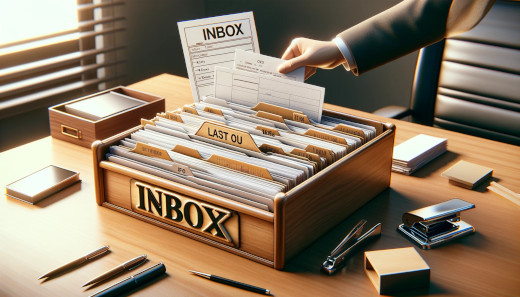
AI-generated image by DALL-E of a wood and paper inbox on a desk
There's nothing like coming back in the morning from a vacation where you worked really, really hard to not check work email for the entire time, only to be faced with a burgeoning inbox of unread messages. As you take a sip of your preferred work-safe beverage and put hands to the keyboard, you are likely thinking, where the hell do I start? Do I sort through those marked urgent (wait, most of them are) or sort by sender and start at the top of the food chain (but that requires recall of the org structure). What do you do?
For me, it's simple - I start with the last email in, at the top, and work my way down. So the last message in is the first out. Last-in, first-out, or as the accountants call it, LIFO.
The Reason for Whom to be Pleasing
I didn't always use this approach. Some of the approaches I mentioned are ones I have used over the years. When you get down to it, it's almost a no-win situation - someone's message won't get read as quickly as they want it to be read. With LIFO, someone is getting responded to quickly, and starting at the top of the list is also easier to manage. My ultimate goal for using LIFO is to get to inbox zero, something I always strive for.
With any process you choose for any task, it's always nice to have some validation for it. Initially I didn't tell anyone about my approach as I didn't want them to be slighted if their messages came in earlier during my out of office period. I got some reassurance of my choice from John C. Dvorak, the veteran technology journalist and co-host of the No Agenda podcast. During one episode he was talking about email and stated he uses LIFO for pretty much the same reasons I do. As he emails with pioneers in technology, I couldn't have a better endorsement.
How do you manage your inbox? Do you LIFO, first-in, first-out or FIFO? Or something else? I welcome your thoughts in the comments to this post. Of course now that my approach is out in the open, I expect more emails to be sent to me just as I return to work.
Deconstructing Last In First Out
Perfection can be the enemy of the good. When it comes to a digital stack of messages before you, choosing a method to process them that you are comfortable with is paramount. My choice of LIFO as a method has worked for me, and it still allows me to sort through my inbox to find, say, messages from my boss if needed.
This is from The Hot Iron, a journal on business and technology by Mike Maddaloni.
Did you enjoy this? Subscribe to The Hot Iron by RSS/XML feed or Read by Email
Strategize • Technology • (0) Comments • PermalinkHeading to the Microsoft Azure And AI Conference December 5 – 7
Next week, Tuesday through Thursday, December 5 through 7, 2023, I will be attending the Microsoft Azure and AI Conference in Orlando. Will you be there too?
The conference includes a wide array of presenters from Microsoft and partner firms on leveraging the latest capabilities of Microsoft’s cloud hosting platform Azure as well as artificial intelligence, or AI – the hottest topic out there in the tech world and beyond.
I will be attending with colleagues from work who all work with Azure in different capacities. This collaboration among peers will heighten my learning for certain over the 3-day conference. I am hoping to take away from this tangible ideas and potential projects to meet our team and organizational goals.
If you are attending feel free to connect with me here and comment on this blog post or you can connect with me on LinkedIn and please no spammy sales pitches.
This is from The Hot Iron, a journal on business and technology by Mike Maddaloni.
Did you enjoy this? Subscribe to The Hot Iron by RSS/XML feed or Read by Email
Announcements • Strategize • Technology • (0) Comments • PermalinkLivestreaming Swim Meets – The Latest and Greatest
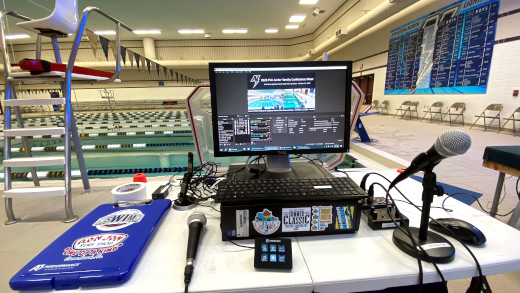
It’s been over a year and a half since I first wrote about the work I and others have done with livestreaming swim meets, and what a time it has been. Since that original post the gear and team has covered over a dozen swim meets to thousands of viewers. Along the way we have made a myriad of improvements to the process and equipment, and I would like to share these as well as what we learned along the way.
Still livestreaming swim meets?
Some reading may be thinking, you’re still livestreaming? Isn’t that a thing of the past? Sure, the efforts started in 2021 was born of necessity, but the demand hasn’t lessened. Where some venue and sports have suspended livestreaming, I and others wholeheartedly disagree. From busy families to distant friends and relatives, the ability to see live action in a quality broadcast persists. Even though there are commercial, automated solutions available where you have to pay to watch a limited-featured broadcast, the emphasis on quality keeps me and the others in our crew doing what we are doing.
The Breakdown
Below I organized the changes and improvements with the software, hardware, audio and content areas of livestreaming. Where the picture above shows our latest configuration, you can watch the culmination of the efforts involved with the latest recorded broadcast of my high school’s hosting of the Junior Varsity Conference swim meet on YouTube.
Software
We are still using OBS Studio and even with the more we have done with it, we are still barely scratching the surface on its capabilities. A combination of built-in features new to us as well as plugins to the platform allowed for ease of management and enhanced capabilities.
We started using Scene Collections for each swim meet and team to better organize them. This allows us to switch between color and scene configurations easily with little required enhancements to them. I say required as many times we are copying scenes from one collection to another due to something new I learned or want to experiment with. For example, I have some collections for a meet with multiple scenes that is manually managed, as well as collection with a single scene for an “autopilot” meet – once I couldn’t be there to direct the meet, so we left a single scene on, and one of the crew started and stopped it for each meet session. The single scene incorporated 2 cameras and the scoreboard, as you can see here:
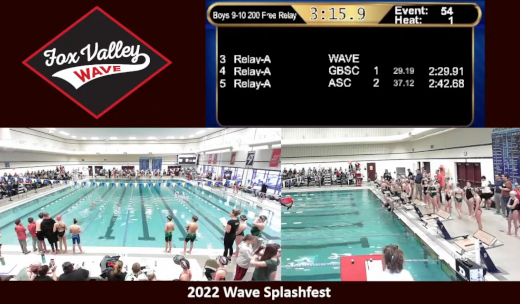
To make the management of scenes easier, I installed the Source Copy plugin for copying and moving scenes between collections. Even if you don’t think you will use this, if you are livestreaming multiple meets or events, you will. Another plug-in we started using was the OBS-NDI v 4.9.2 from dev47apps for NDI cameras and iPhone. This allowed us to use our iPhones as a Web cam, and it was amazingly easy to do so. In addition to the plug-in we installed the NDI HX Camera app on our iPhones. Where the app was a little on the pricey side at US$20, it was worth what we gained in flexibility. As long as the iPhone was on the same network as the OBS computer, we could simply select the NDI source and what was on the phone was in a scene. We experimented with this at our summer meets to get close-up footage of races ending at the far end of the pool as well as a roving camera for awards presentations.
Other enhancements to our livestreams came from learning features in OBS. As our scoreboard was out for a while, we had a need to easily update the current event and heat in the swim meet. We did this with loading the events and heats into a text file with each one on its own line, then used this in a text source to read the first line of the file. When editing the text file to remove the top line, upon saving it the new top line would appear in the scene. Another enhanced use of text was to add a crawler or horizontally-scrolling text on a scene. This tutorial is a good example of how to add a crawler.
Hardware
Although we only made one true addition to our hardware, it was a significant one – an Elgato Stream Deck Mini. A Stream Deck is a device with multiple buttons that can be programmed by accompanying software on the computer to execute any commands, and not just for OBS, but it is very popular among livestreamers. After much deliberation I decided on the Mini with just 6 buttons. Why? There are usually a handful of scenes that are a go-to, and programming them to Stream Deck buttons made scene switching a breeze. And with only 6, sometimes you didn’t even need to look at the buttons to know where which was which. We did program one button to throw up a graphic with no sound as an “oh shit” scene in case we needed to cut away from all cameras.
Another enhancement could fall under hardware, and that was the use of 3M Command strips and hooks. We use the Velcro-like Command strips to mount the cameras, and they stay up with no problems. We also use Command hooks for running cables along the walls. The nice thing about them is that even though they are designed to easily be removed, the strips and hooks have stayed up in the high-humidity environment of a pool for several years now.
Audio
Audio thus far has been an Achilles’ Heel of the broadcasts. The first few meets we livestreamed years ago did not have any audio at all. Where later on we toyed with tapping into the swim meet announcer’s microphone, we decided to add our own audio and do our own play-by-play. We have been lucky to have the announcer we do for the high school girls swim meets, and I have been getting more comfortable with this duty as time goes on, building on my meet announcing experience.
When the mic was off, however, we would not be sending any audio over the livestream. This would throw YouTube warnings we simply ignored. It also made for a poor audio experience to go from dead air to someone’s booming voice. I was able to eliminate the dead air by adding an open source audio file of ambient indoor pool sounds and looping it. There are many out there to choose from, and unfortunately I never saved the source link for the main file I use to share with you. This looping audio allowed for a more overall natural sounding broadcast.
Originally the mic we used was a low-end USB mic, and it did a good job but not a great one. The sound was distorted and even with some adjustments to OBS audio settings there wasn’t much improvement. We then decided to up the game by borrowing a mixer and an XLR microphone. The quality improved but there was static and some distortion I attributed to the audio cable between the mixer and the computer audio input jack. When I decided to try a USB cable I found this refurbished mini USB Pyle mixer for the same price of a cable. Adding 2 Shure PGA48 microphones gave us a dramatically better sounding broadcast, as can be heard in the meet livestream link above.
Content
Building upon bringing in the Web scoreboard mentioned in the last post, I wanted to see if we could bring in what was displayed on the Daktronics scoreboard for high school meets. As I mentioned earlier the scoreboard was out for a few meets, but when it came back a representative from Daktronics was at the meet and I politely cornered him to ask how we could do this. It turns out the scoreboard console generates a Web page with the image of what’s live on the scoreboard. We were able to take the URL of that Web page into a browser source so the entire scoreboard could be in its own scene, as shown here:
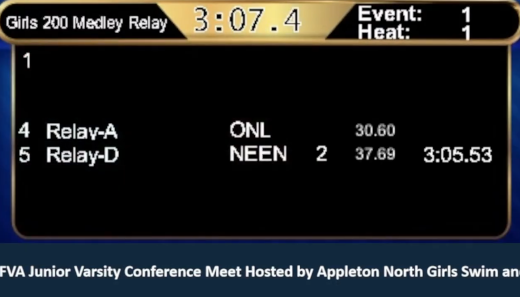
As well, I added a crop of the scoreboard and put it at the top of all scenes so the event, heat, event title and clock was always displayed on all scenes, as shown here:
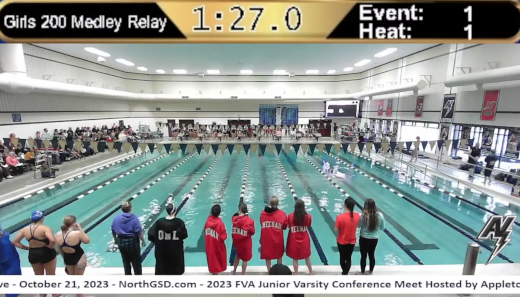
Other content improvements included custom thumbnail images for each meet in YouTube. These were created using GIMP, open-source graphics software comparable to PhotoShop, then taking the image with the meet logo and text and setting it in YouTube Studio for the livestream. I also made a video of the school’s logo and animated text using Canva, a cloud-based, easy to use design platform. Although I only have the free version, I was impressed with how much I could do with it.
So What’s Next?
Where the list of improvements is not only long but game-changing for our livestreams, there still more I want to do. There are many features of OBS I have yet to play with, and if only I had the luxury of time to research and experiment more.
A hold-over from the last post was a pan-tilt-zoom, or PTZ, camera. An example of one is the Move 4K from PTZOptics. A challenge we have is the cameras would be mostly used outdoors or in high-humidity natatoriums. Surprisingly we have had little issues with our ~US$50 Webcams and can afford to have extras. But with prices starting at ten-times that of a standard Webcam, it’s outside of my own budget. To mitigate any issues with the environment, PTZOptics has partnered with a firm to make outdoor camera covers. These are nothing short of amazing, but carry a cost as much as a camera and would add significantly to our load and the logistics of how to mount them as it is huge. All that being said, recently learning about these makes them more within reach.
Deconstructing Livestreaming Improvements
My trajectory for our livestreaming efforts is to make a broadcast that I and others would enjoy watching. Where for years people have – and still do – say what they are looking at is good enough, it is because there is no other option for them. As is clearly stated in the text and pictures here, there’s a better way. With a small investment in time and equipment, a quality livestream experience can become a reality for all.
This is from The Hot Iron, a journal on business and technology by Mike Maddaloni.
Did you enjoy this? Subscribe to The Hot Iron by RSS/XML feed or Read by Email
Strategize • Technology • Thrive • (0) Comments • PermalinkBreaking A Work Promise To Myself

As the passing of the first third of the year is upon us, I am already breaking one of the 2 promises I made to myself at the beginning of 2023 regarding how I work. It was not a resolution, rather a small behavioral change for me to be more efficient and perhaps even more effective.
That promise was to not take any paper notes and only record things digitally.
Literally Getting Out of Hand
The genesis for this move was an ongoing pile of papers – some small Post-Its, others full notebook pages – that was becoming a bottleneck to reviewing discussions and even completing tasks. I would always have some form of paper at hand to scribble notes and manage priorities throughout the workday. I often found that taking notes by hand was more efficient in being active in meetings, an idea that has been reinforced by other colleagues and articles I have read.
For the most part this cutting out paper worked for me. I would still occasionally print a draft of a document for editing, but after applying those changes to the document file I’d promptly recycle the paper. Several times I consciously stopped myself from trying to write something down, a reaction I was able to curb by simply not carrying a notebook or paper with me. The notes I captured would go directly into my Microsoft OneNote file, which is where the written notes would eventually go as well.
Over time, there was one piece of paper I found that I needed to go back to keeping alongside me throughout the day – my personal dashboard. This is a landscape piece of paper, printed from an Excel file, with columns for projects or areas that I am working on and rows for high-level tasks or issues for each. It’s not a task list per se, rather something I refer to have everything I or my team are working on available at a glance. Thus the term dashboard applies well.
My current dashboard has 7 columns, with the last one being for “personal and professional growth.” It had 6 columns the other day, but as another project came to fruition it warranted its own column. As I am working on multiple projects with my goal to focus blocks of time on one thing at a time and avoid multitasking (as much as I can), the dashboard is a reminder of all else going on in my world.
A Break or a Bend?
Talking with some colleagues about this, there was doubt from them I was actually breaking a promise and instead bending it. To stop consuming paper was not the catalyst of this decision, but it was a nice by-product. However I consider it a break, and until I have a different system – or less going on at once – the dashboard will remain with me as I find it effective.
What was that other promise I made you may be asking? To stop asking people to turn on their cameras in work online meetings! By now, if people don’t want their camera on or realize the benefits to work culture, who am I change their minds? I have also been guilty of not having my own on as much as I used to, especially when I am the only person who turns their camera on for a meeting.
Deconstructing Breaking Promises
Looking back on my earlier decision, where I am somewhat disappointed I was not able to carry through with promise, it has certainly not broken me. Reevaluating earlier decisions or what we do is something we should actually take time out for rather than it be solely reactive and come from frustration or other emotions.
This is from The Hot Iron, a journal on business and technology by Mike Maddaloni.
Did you enjoy this? Subscribe to The Hot Iron by RSS/XML feed or Read by Email
Business • Strategize • Technology • (2) Comments • Permalink
